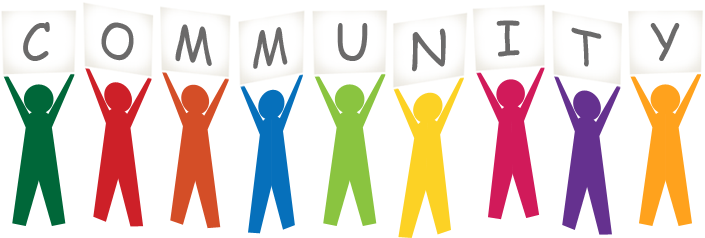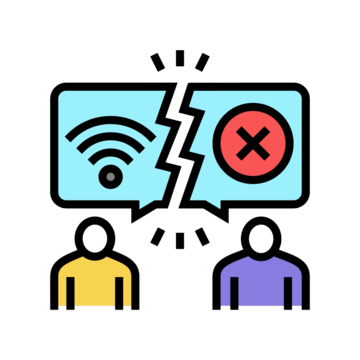Ocean
THE PROPOSED INNOVATIVE SOLUTIONS AND INTERVENTION
SUMMARY OF THE PROBLEM SITUATION
A comprehensive analysis of the digital divide in Rolford City, particularly focusing on its impact on youth and vulnerable populations like Mena. By employing diverse theories, methodologies, and problem-solving tools, gain a deeper understanding of the root causes and complexities of the issue, as well as identify effective interventions and solutions.
Soft Systems Methodology (SSM) is an excellent approach for tackling complex, ill-defined problems like the digital divide. It emphasizes understanding the perspectives of stakeholders, identifying problem situations, and designing feasible interventions that address underlying systemic issues.
In Mena's case, conducting stakeholder interviews and participatory workshops could help uncover the specific challenges she faces in accessing education, employment opportunities, healthcare, and government services due to digital exclusion. Understanding Mena's needs and experiences, as well as those of other marginalized youth in Rolford City, will be crucial for developing targeted solutions.
Analysing the problem situation using theories such as the digital divide framework, social exclusion theory, and theories of poverty and inequality will provide valuable insights into the underlying factors contributing to digital exclusion among Rolford City's youth.
Techniques such as community mapping, resource mapping, and SWOT analysis can help identify existing resources, strengths, weaknesses, opportunities, and threats related to addressing the digital divide in Rolford City.
Overall, by integrating diverse theories, methodologies, and problem-solving tools, you'll be well-equipped to develop effective solutions and interventions that address the digital divide in Rolford City and empower marginalized youth like Mena to fully participate in the digital age.
THEORIES AND METHODOLOGIES
SOFT SYSTEMS METHODOLOGY
The Soft Systems Methodology (SSM) was developed by researchers at Lancaster University to use Systems Engineering techniques to address business and management problems. However, they found that applying a Hard Systems approach to fix business problems often failed at the initial stage of defining the problem.
This occurs purely because the many stakeholders hold varying opinions about the components of the system, its goal, and consequently the issue. Two influential figures in the creation of the SSM are Peter Checkland (1999) and Brian Wilson (2001), who combined a pragmatic and practical approach to the discovery and resolution of "soft" ill-defined problems through "action research." Checkland and Wilson created a series of tools to assist users in completing the tasks, thus this technique was more than just a procedure.
- Rich Picture
- Conceptual Model
- CATWOE
- The Formal System Model
A picture of the SSM is shown below. Since its inception in the 1970s and 1980s, it has evolved as a result of the contributions of numerous workers. A seven-step procedural approach to SSM is shown below. I have opted for this perspective because, despite being an early depiction, it does manage to clarify a number of crucial and significant facets of SSM. (Burge Hughes Walsh, 2015)
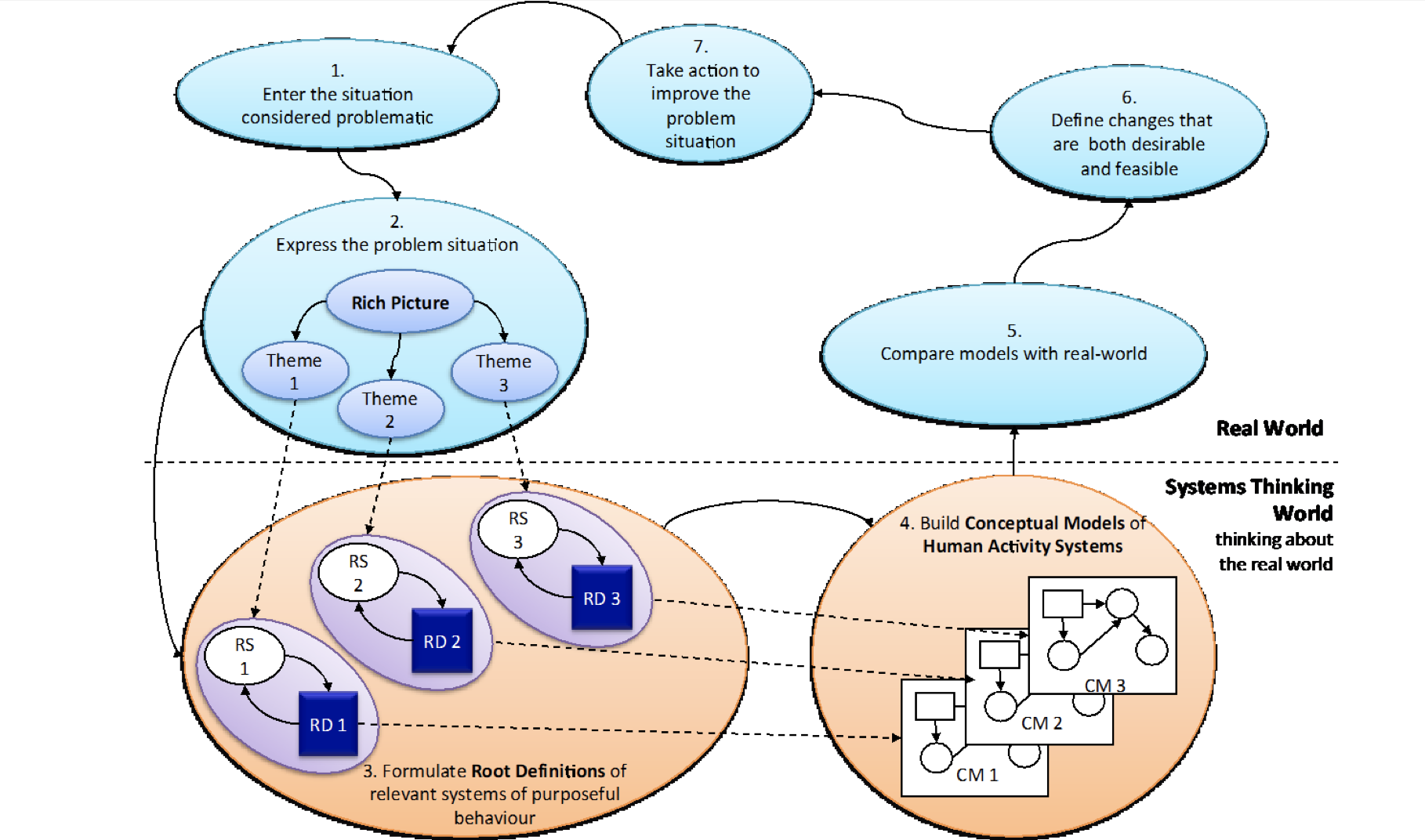
7 STEPS OF SOFT SYSTEMS METHODOLOGY
SITUATIONAL THEORY OF PROBLEM SOLVING (STOP)
The situational theory of problem solving attempts to explain why and how an individual communicates during a problematic situation. The situational theory of problem solving (STOPS) was proposed by Jeong-Nam Kim and James E. Grunig in 2011 though their article “problem solving and communicative action: A situational theory of problem solving.” The theory was developed from the situational theory of publics (STP) and claimed it is “an extended and generalized version” of STP. This theory has an assumption that “the more one commits to problem resolution, the more one becomes acquisitive of information pertaining to the problem, selective in dealing with information, and transmissive in giving it to others.”
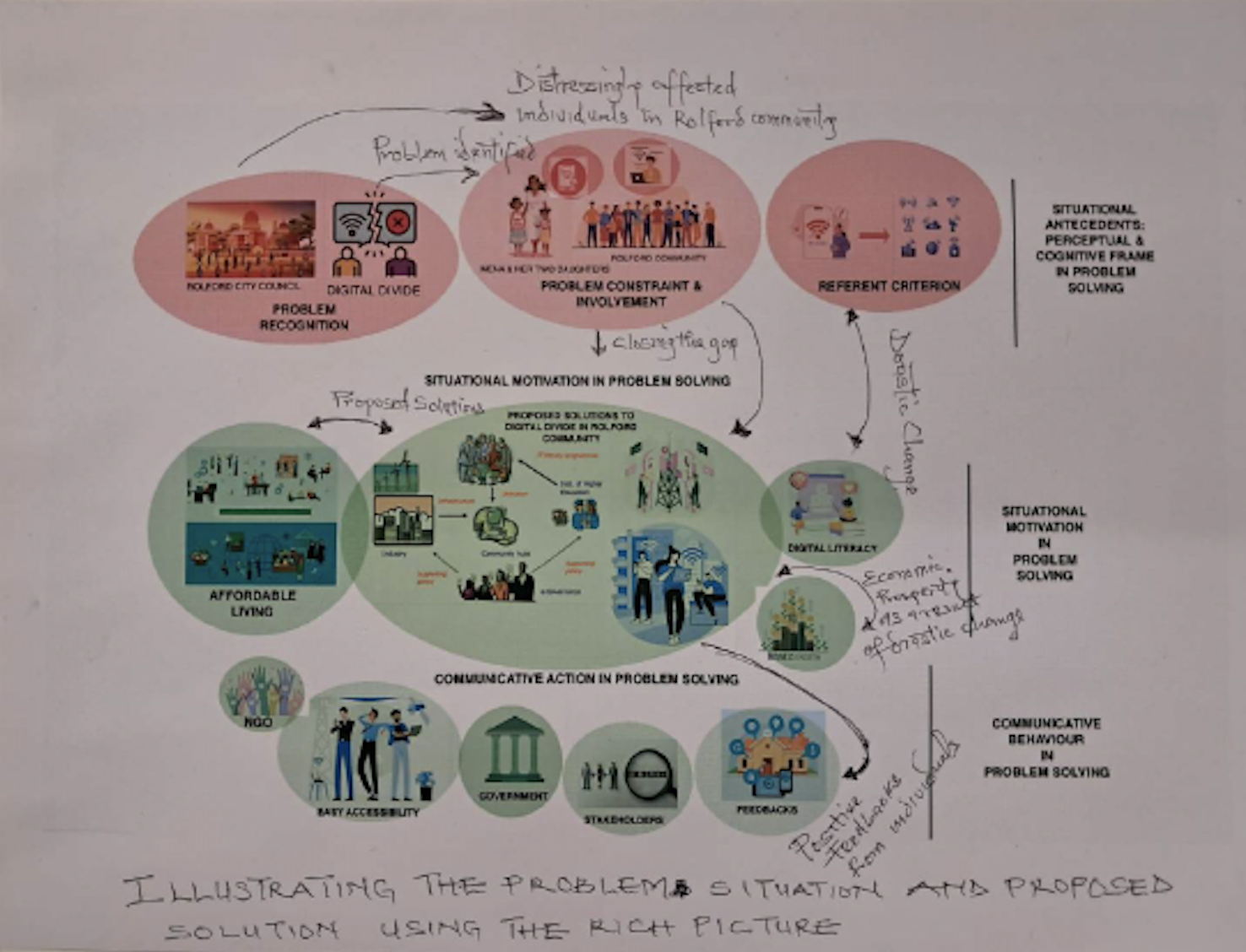
ROOT DEFINITION OF RELEVANT SYSTEMS
To effectively utilise CATWOE (Customers, Actors, Transformation, Worldview, Owner, and Environment) analysis alongside Root Cause analysis, a structured approach can be implemented to comprehend and analyse wicked problems. Once put into practice, the suggested solutions will accelerate the enhancement of locals' quality of life by making it easier for them to obtain necessary technological services.
CATWOE ANALYSIS IN THE ROLFORD COMMUNITY
CATWOE is a powerful framework used in Soft Systems Methodology (SSM) to analyse complex problem situations and guide decision-making processes.
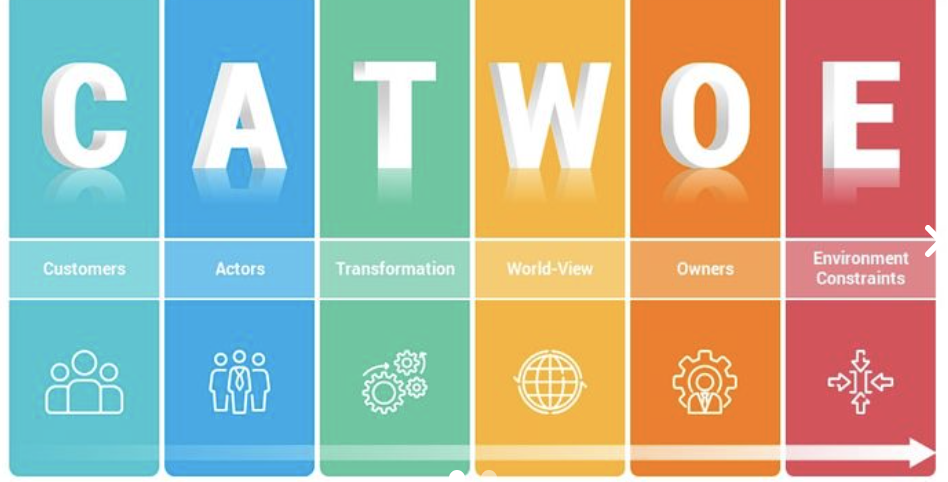
CUSTOMERS
The Rolford Community members are currently experiencing the effects of the digital divide, particularly those with limited digital access and financial resources, as well as those facing challenges with digital literacy. Sadly, these disparities are significantly impacting their daily lives. However, proposed solutions aim to enhance the residents' quality of life by offering improved access to essential services within their community. Once implemented, these solutions will serve as a driving force for positive change.
ACTORS
Various organizations such as governmental bodies, academic institutions and service providers are willing to collaborate to address the digital gap in the Rolford community. These interested parties will play a crucial role in implementing the recommended solutions that aim to foster positive transformation and advancement within the community.
TRANSFORMATION
The transformation process involves putting into practice the recommended solutions, such as setting up digital learning centres that can be shared, enhancing digital infrastructure, adopting affordable internet initiatives, and providing digital resources. The city's improved digital literacy and self-assurance stems from the implementation of public wireless connectivity and workshops that offer digital skills training.
WORLDVIEW
The community stakeholders believe that limited digital exposure has negatively impacted the skill-building and talent pool of the next generation of workers, leading to significant consequences for the United Kingdom and affecting about 6% of the population. To address the digital divide, particularly in low-income neighbourhoods, the Rolford City Council is taking proactive measures to seek outside aid and support. The council is committed to tackling this issue head-on and leading the city towards meaningful action to bridge the digital divide.
OWNERS
A consortium of key stakeholders has been entrusted with the task of enhancing the standard of living for residents by spearheading the transformation of the area into a cutting-edge metropolis. This coalition comprises of esteemed educational institutions, government bodies, and the Rolford City Council, a significant stakeholder with a vested interest in the project, as illustrated in the comprehensive visual depiction provided.
ENVIRONMENT
Located in Rolford City, northwest of the United Kingdom, is a thriving town that takes pride in its multicultural population's diversity. However, the digital divide is currently a problem in the neighborhood's impoverished areas. The Rolford city council has proactively taken action to improve people' general quality of life and opportunities in order to address this concern. In order to close the digital divide and build a more just community, the council has developed plans to mobilise outside resources and implement big changes.
THE ROOT CAUSE ANALYSIS FOR THE ROLFORD COMMUNITY
"A valuable technique for preventing similar incidents in the future is Root Cause Analysis, which can reveal not only the what and how of an occurrence, but also the why (Rooney & Vanden Hauvel, 2004)." Through the application of suitable remedial actions, root cause analysis can successfully tackle the fundamental problems. For this reason, it is a vital instrument in helping the Rolford community promote digital inclusion and close the digital gap.
In order to do this, we will apply the "5 WHY'S" approach to look into the root reasons, choose appropriate remedial measures, and create the procedural solutions needed to successfully close the divide within the Rolford community.
THE ROOT PROBLEM: DIGITAL DIVIDE IN ROLFORD COMMUNITY
Root Cause 1
Low levels of digital literacy and inadequate access to learning materials.Counter Measure: The lack of digital literacy among many people is a significant issue that must be addressed. In order to tackle this problem, we need to take steps to ensure easy access to high-quality learning materials. By providing these resources, we can equip individuals with valuable skills that will enable them to thrive in the digital age.
Root Cause 2
Insufficient digital infrastructure leading to poor connectionCounter Measure: High amounts of money are required to cater to device expenses, optimize spectrum allocation, expand mobile broadband services, and improve infrastructure security. This includes constructing digital infrastructure, particularly broadband networks, that are crucial for ubiquitous and dependable internet access.
Root Cause 3
High cost of computers and internet connections preventing low-income residents using these resources.Counter Measure: By forming strategic partnerships with service providers and making targeted investments in subsidised technology initiatives, stakeholders can effectively reduce the digital divide. This means ensuring that all individuals have access to affordable and reliable internet services and devices, regardless of their socioeconomic status. Additionally, these efforts can help promote educational equity by providing equal opportunities for learning and skill development. By empowering underserved communities with the necessary resources, knowledge, and support, we can enable them to not just adapt to but also thrive in the digital age, opening up new opportunities for personal and professional growth.
Root Cause 4
Limited internet availability in public places restricts people's connectivity.Counter Measure: Create public Wi-Fi hotspots in strategic locations such as parks, libraries, public transport, and city centres to provide free internet access to individuals in the neighbourhood.
Root Cause 5
Inadequate knowledge and expertise in utilising digital tools.Counter Measure: Host workshops to teach communities how to use internet resources and digital tools, and help them access essential services online.
The CATWOE Analysis and the Root Cause Analysis both focus on the digital divide within the Rolford community. They identify stakeholders, such as community members and government bodies, and propose solutions to improve digital literacy and access. The analyses highlight the significant impact on the environment, particularly in low-income areas, and emphasize the crucial role of the Rolford City Council.
It is widely believed that the digital divide stems from several underlying problems, such as inadequate digital literacy, limited internet access, and costly digital services. This view is consistent with the Root Cause Analysis approach adopted by 5 WHY, which recommends solutions such as infrastructure enhancements, digital skills training, and the establishment of digital learning centres to support CATWOE's transformative vision. Overall, these studies present a comprehensive strategy for bridging the digital divide that involves collaboration among various stakeholders and fosters the development of the community's digital ecosystem.
DEVELOPMENT OF THE RELEVANT PROBLEM
The Rolford Community experiences a digital divide due to various factors, including socioeconomic status, education, employment opportunities, and access to essential services. These elements are interconnected and have had negative impacts on the community.
The interconnected nature of our society's key systems and elements is influenced by a variety of socioeconomic factors, which can pose obstacles to accessing modern information and communication technology (ICT). This lack of digital access can hinder individuals from obtaining vital resources such as education and job opportunities, impacting both the younger and older members of the community. Consequently, many digital opportunities remain inaccessible to these individuals.
Mena, a single mother, faces a challenging situation in taking care of her two daughters, Nouf and Hanayin. This is just one example of the many feedback loops that occur in Rolford society. Mena is particularly impacted by the digital divide, which is exacerbated by socioeconomic inequality and the higher expectations of the digital world. The entire community is negatively affected by this issue.
The collaboration of the Rolford City Council, educational institutions, service providers, government agencies, and community organizations is vital in effecting change. Each stakeholder holds a pivotal role in shaping societal systems and has the capacity to bridge the digital divide through the implementation of effective policies, enhanced education, improved services, adoption of new technologies, and more. Through collective effort, these stakeholders can propel the community forward and mitigate the digital divide.
The identification of the root causes has helped us understand the origin of the problem, its contributing factors, and the potential effectiveness of solutions that rely on stakeholder engagement.
THE PROPOSED SOLUTIONS AND INTERVENTION
Solution 1
Provision of Sophisticated Broadband Connection
This solution will bring about drastic change to the lives of the residents and end the seemingly problem of digital divide. The communal efforts coupled with relevant stakeholders will fast track the possibility of broadband connectivity.
Solution 2
Creation of Public Wi-Fi Zones
Public Wi-Fi zones should be strategically created massively to enable the residents enjoy internet facilities on the go and everywhere without any hitch or barrier.
Solution 3
Community Tech Hubs
The tech hubs are the centres for computer education, training and developing individuals for personal growth most especially in the tech industry by way of empowering the residents through ideal digital skills, giving the community a better living and improving their standards.
Solution 4
Subsidising Internet Facilities
Giving subsidies on internet facilities will go a long way helping the low-income individuals live a better and improved lives by way being able to afford the needed facilities even in their own little way.
Solution 5
Digital Literacy Sensitisation Programs
Sensitisation programmes on digital literacy should be adopted to encourage as well as ginger individuals to see the need to be educated in the latest technologies and embrace the change that will transform their lives digitally.
THE PROJECT ACTION PLANS
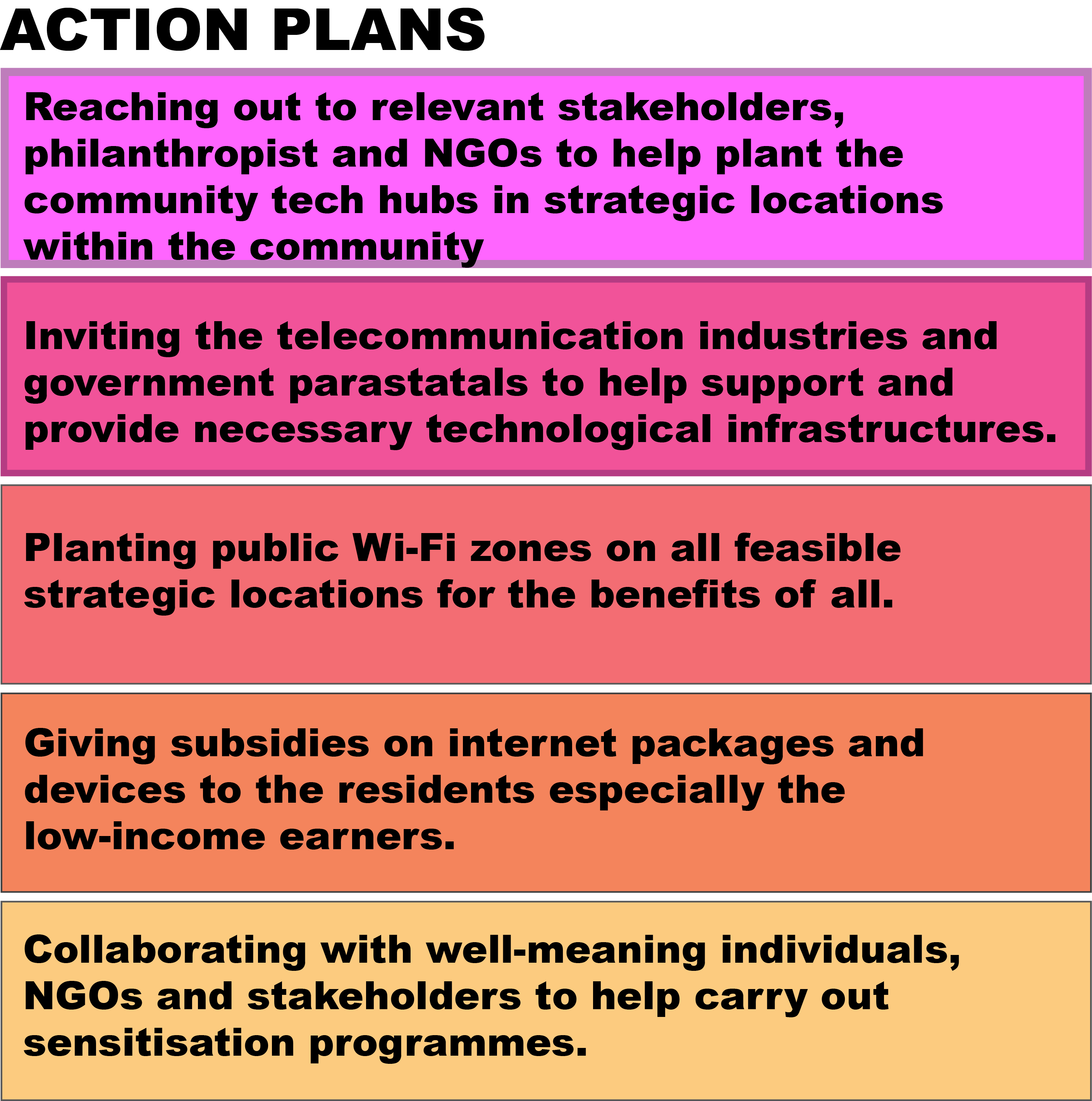
APPLICATION OF CHANGE MANAGEMENT PRINCIPLES TO ENACT ACTIONS FOR PROBLEM IMPROVEMENT
It is crucial to not only identify solutions but also take proactive steps to implement them within the community. This approach is essential because societal changes inevitably lead to a change curve that individuals go through, including stages such as shock, denial, frustration, and doubt.
Lewin's three-stage transition model can be utilised to manage a change that may cause residents to experience a range of emotions and experiences.
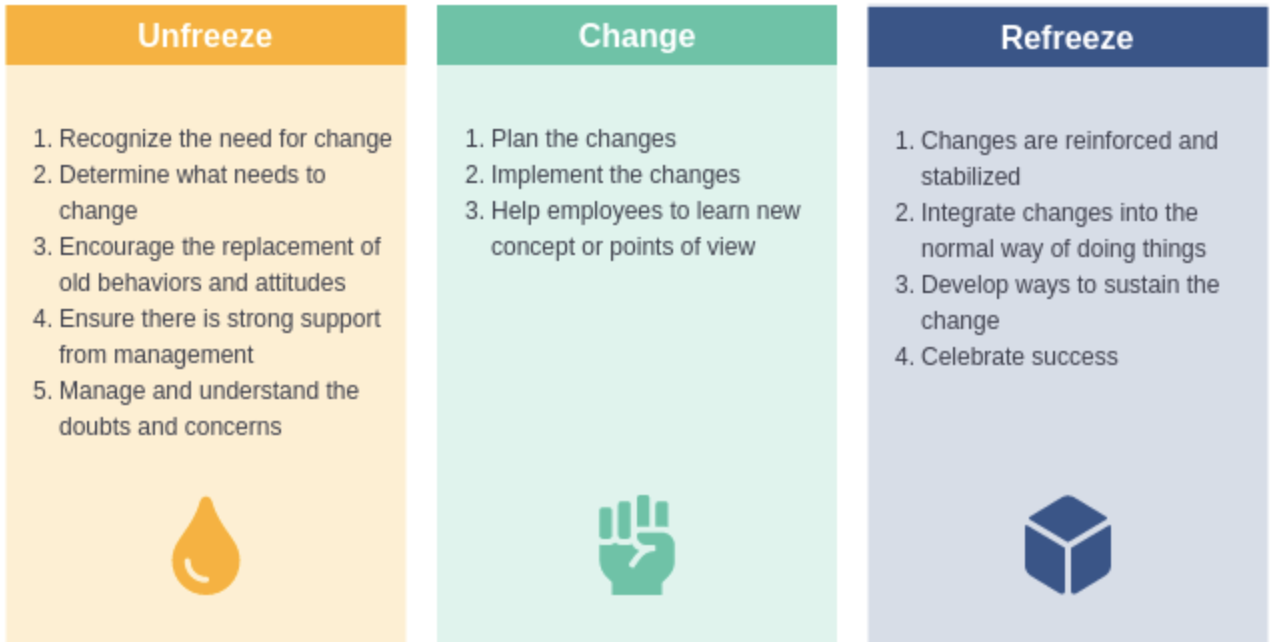
Unfreezing (Readiness to change): The entire Rolford community must prepare for the impending digital transformation to ensure greater acceptance and adaptation of technology.
Changing (Implementation): This stage involves enlisting the aid of external stakeholders such as the government, educational institutions, and service providers to implement the proposed solutions.
Refreezing (Making it stick): The final stage oversees the ongoing monitoring and assessment of the effectiveness of the solution, ensuring the long-term incorporation of change within the community.
In summary, the government and external stakeholders can offer support through financial assistance, increasing awareness, helping with implementation, and ensuring that proposed solutions and community changes are sustainable. Upon successful implementation of these improvements, this collective effort has the potential to result in positive outcomes and continuous feedback from residents.

